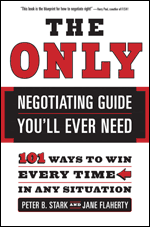 One of the most frequent questions I am asked is, “Should I counter or should I accept the first offer?” This is usually followed by, “I don’t want to jinx my deal by countering when I felt the original offer was acceptable.”
One of the most frequent questions I am asked is, “Should I counter or should I accept the first offer?” This is usually followed by, “I don’t want to jinx my deal by countering when I felt the original offer was acceptable.”
As a general rule, you should never accept the first offer. Why? People expect you to counter and I believe you should not disappoint them. When you don’t counter the original offer, you leave your counterpart with two bad thoughts: they should have made an even better first round offer, and there must be something wrong with your willingness to agree so quickly.
Let’s say that I’m selling my used 2008 Ford F150 King Ranch pick up for $21,000. You come by to look at my truck, take it for a test drive and then return, saying, “Your truck is in excellent condition and I am comfortable with the $21,000 price. Would you prefer a cashier’s check or all cash?” Now you have left me with the terrible thought that I priced my truck too low and I now think I could have easily gotten more from you. On top of this, I may be suspicious about you wanting to finalize the deal so quickly.



